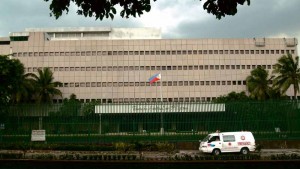Finally, after more than a month of hemming and hawing, the administration of the motorbiking Duterte Harley rose to the occasion and decided that, indeed, we would import rice.
It seemed to be a no brainer because the previous administration of our leader Benigno Simeon, aka BS, neglected the agriculture sector altogether, for one.
But Agriculture Secretary Manuel Piñol, known as a longtime close-in of Duterte Harley, insisted to pursue our elusive dream of rice self-sufficiency.
From day one, Duterte Harley declared that his administration would stop rice importation to support farmers.
Last Monday, in a major policy shift, the Cabinet decided to allow rice importation, seemingly as a matter of public survival.
We just would not have enough rice, despite the rosy forecast of a 30-percent increase in rice production in 2017, reaching almost 23 million metric tons.
The Department of Agriculture of course crowed about what Piñol called “bumper harvest,” splattered all over the DA press releases and even Facebook posts.
But even the impressive “bumper” harvest would not be enough.
According to the study by the Southeast Asian Regional Center (Searca) for Graduate Study and Research, which was commissioned by the Philippine Rice Research Institute (PRRI), each Filipino would eat an average of 119 kilograms of rice annually.
With a population of more than 100 million, yearly rice consumption would reach almost 1.2 MT.
There—take that alongside the 23 MT in “bumper” harvest in the last season, and you could understand why Duterte Harley changed his mind.
The DA nevertheless insisted on a “no import” policy during the harvest season.
Now, the lean months would be coming, traditionally set from July to September, the rainy season when rice production would be at its lowest.
As part of food security preparation, the government wants to have a 30-day buffer of rice during those lean months.
Thus as its mandate, the NFA should assure that, during those lean months, we would have enough rice in storage to feed more than 100 million people for 30 days.
As of last Monday, when the Cabinet decided to put an end to all the squabbling over rice importation, the buffer stood at a dangerous level of only 8 days.
The administration thus feared an impending rice shortage, which would certainly lead to drastic increases in the price of the staple food, so that even farmers in rural areas would be affected.
And so how would the policy of absolute non-importation be good for farmers?
Even after the administration changed its mind, one big question remained: How much rice should we actually import.
Volume was actually another bone of contention, and so far the government would only allow the so-called MAV, the minimum access volume, totaling some 805,000 MT, meaning, the importation would enjoy reduced tariff of 35 percent, versus 40 percent for ordinary importation.
There would be another 250,000 MTs of importation under a “standby authority.”
Uh-oh, that sounded like a lot of discretion for some government officials.
Big money in rice importation, easily amounting to billions of pesos per shipment, actually opened it to all sorts of foolishness such as smuggling and graft and corruption, particularly those involving the NFA.
Reports said that NFA Administrator Jason Laureano Aquino had, for instance, defied the NFAC, the governing body of the NFA.
The NFAC ordered Aquino to extend import permits that expired at the end of March 2017, and so he simply allowed shipments only from Pakistan and India.
He then ordered the seizure of shipments from Thailand and Vietnam.
Those imports were done by legitimate companies, like the Pilmico Food of the Aboitiz group, which joined the MAV program in good faith, but were suddenly treated like smugglers, although they already paid for the duties in advance.
As it turned out, the NFA secretly carried out some backdoor negotiations with Vietnam and Thailand for government-to-government importation.
By the way, the powerful rice syndicates in this country would actually kill for government-to-government importation, including the huge rebates in the deals.


